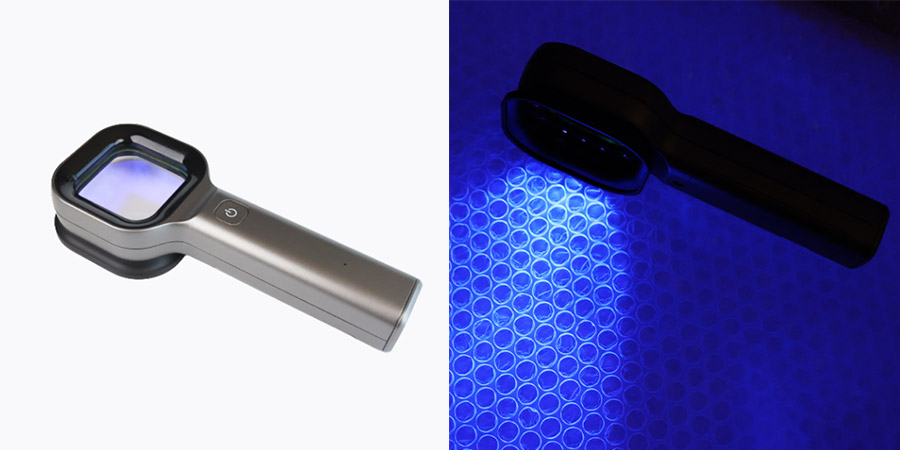Wood’s lamp examination is a tool healthcare providers use to examine your skin, scalp and hair. The lamp emits ultraviolet (UV) light, or blacklight, which makes certain types of cells glow or turn colors. This quick, painless test is often used to help diagnose fungal, bacterial and parasitic infections.

What is a Wood’s lamp examination?
A Wood’s lamp examination is a simple test that can identify certain conditions on your skin, scalp and hair. It’s often used to help diagnose fungal, bacterial and parasitic infections.
The lamp uses long-wave ultraviolet (UV) light to make certain cells show color or appear fluorescent.
The tool, developed by American physicist Robert Wood, is also called:
Blacklight test.
Ultraviolet light test.
Wood’s light test.
What can a Wood’s lamp diagnose?
Wood’s lamp examination can help healthcare providers diagnose several disorders, including:
Abnormal pigmentation, such as melasma and vitiligo.
Bacterial infection, including Pseudomonas and Corynebacterium.
Corneal abrasion.
Porphyria.
Scabies and head lice.
Skin fungus infections, including ringworm, tinea capitis (scalp ringworm) or tinea versicolor (yeast infection on the skin).
Skin imperfections such as acne, aging skin and milia.
Who performs this exam?
Skin doctors called dermatologists often use Wood’s lamp. But other healthcare professionals also may perform the test, including primary care providers and nurses.
What else can Wood’s light detect?
The tool also is used for nonmedical purposes. For example:
Banks can use the tool to detect counterfeit money.
Bouncers can check hand stamps for people re-entering a bar or club.
Immigration officers can check passports to make sure they’re real.
Law-enforcement officers can check crime scenes for urine or semen.
Museums, jewelers and scientists can examine paintings, sculptures, minerals and gems.
How does a Wood’s lamp work?
A Wood’s lamp emits black light, which is ultraviolet and can’t be seen by the naked human eye. It also emits a tiny bit of light on the violet spectrum, which can be seen by the naked human eye.
When the UV light shines on skin or another surface, some cells appear differently. Certain colors indicate healthy skin. Other colors, or a glowing appearance, might reveal unhealthy cells, such as fungus or bacteria.
How do I prepare for a Wood’s light exam?
Before a Wood’s lamp examination, your skin should be clean but not recently washed. Don’t apply makeup, deodorant, creams or other products to your skin or scalp before the test. Those products can affect the results.
What can I expect during the blacklight test?
A Wood’s lamp doesn’t emit any heat and the test is painless. Your healthcare provider will take the following steps to conduct a Wood’s light examination:
Make the room completely dark. This may involve turning off overhead lights, closing window shades or using a black drape over your skin.
Turn on the Wood’s lamp, which will glow a bit.
Wait about a minute to let the lamp warm up and let their eyes adjust to the darkness.
Put on safety goggles or glasses.
Hold the lamp about 5 inches away from you to look at your skin for a few seconds.
Turn off the lamp, then turn on the lights in the room.
What are the risks of a Wood’s light exam?
A UV light test is safe and doesn’t cause any skin damage. Very rarely, in people with extreme light sensitivity, the lamp can cause a temporary rash.
However, the lamp can cause damage to your eyes, particularly with repeat exposure. Your healthcare provider may ask you to close your eyes or wear protective goggles during the exam.
Results and Follow-Up
When should I know the results of a Wood’s light test?
Your healthcare provider will discuss the results with you immediately after the test. To make a specific diagnosis, they also might consider your health history, symptoms and other test results.
What do Wood’s lamp colors mean?
Normal, healthy human skin under UV light looks bluish. Other colors on relatively healthy skin might be:
White: Areas of thick skin (or possibly lint from clothing).
Yellow: Oily skin.
Purple: Dry or dehydrated skin.
If your skin shows another color or glows (fluorescent or luminescent), it might reveal an infection or other condition. For example:
Bright blue-white might indicate hypopigmentation or depigmentation (too little pigment).
Brown might identify hyperpigmentation (too much pigment).
Blue-green might reveal certain fungal infections.
Coral pink may suggest a bacterial infection.
Pink-red might mean porphyria.
White or gray spots on your scalp can indicate head lice.
Yellow or orange can help identify certain yeast.
A note from Cleveland Clinic
Wood’s lamp examination is a simple, painless, risk-free test that can identify certain conditions on your skin, scalp and hair. The UV light test, along with your health history and symptoms, can help diagnose infections and other issues. The test takes only a few minutes and results are available immediately.